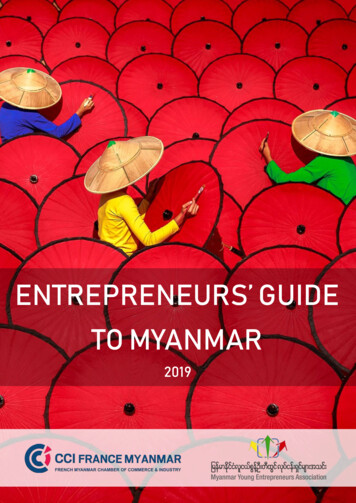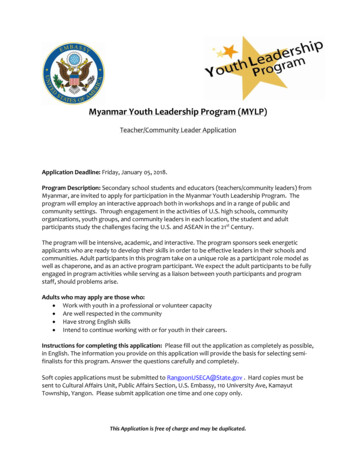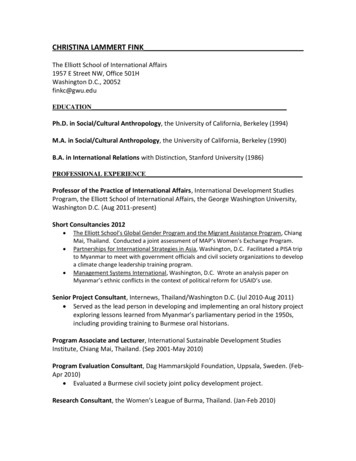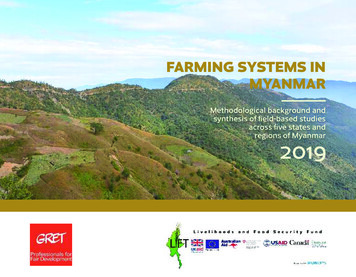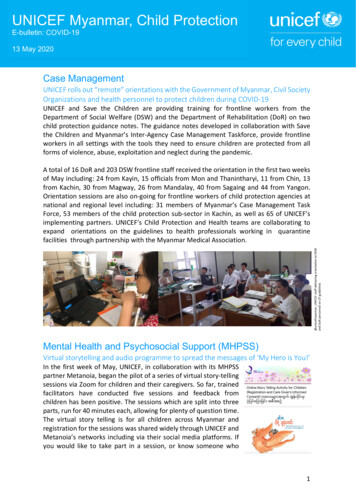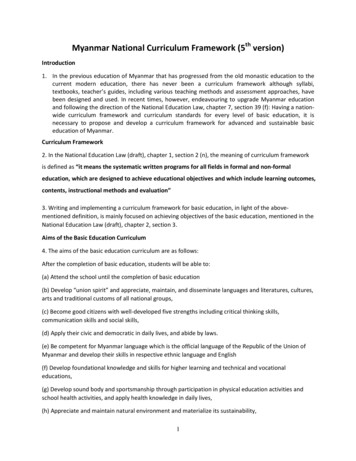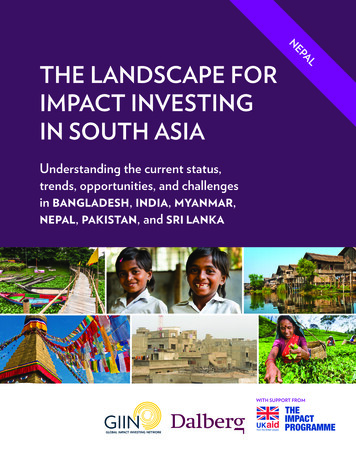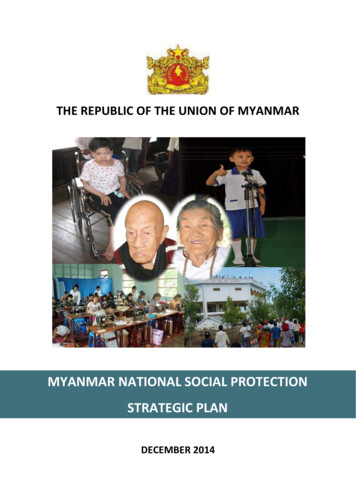
Transcription
THE REPUBLIC OF THE UNION OF MYANMARMYANMAR NATIONAL SOCIAL PROTECTIONSTRATEGIC PLANDECEMBER 2014
THE REPUBLIC OF THE UNION OF MYANMARMYANMAR NATIONAL SOCIAL PROTECTIONSTRATEGIC PLANDECEMBER 2014
PresidentAgga Maha Thayay Sithu, Agga Maha Thiri Thudhamma U Thein Sein
rii:,'.ra':,,:Ji*;:".if; ?r]:::ii:::]i:ll.-;r:'-f l::;::'.:jj3.,i.t?l'';1-,'iiiU Thein SeinPresidenta1j.-.:':1'-:'!'.j;':j'fI acknowledge and appreciatetheerts of all individuals-and :;: i,,.'J
We firmly believe we can collectively build a Myanmar societywhere equality and harmony flourish by reinforcing socialprotection amidst the rapid reforms.His Excellency, President U Thein SeinJune 25, 2012National Social Protection Forum
Table of ContentsPREFACEACRONYMS1. Introduction2. Social Protection as a Priority in Myanmar’s Socio-Economic Reform111Programme3. Poverty, Risk and Vulnerability in Myanmar194. Myanmar’s Current Social Protection Programmes335. Social Protection for All: Myanmar’s Social Protection Strategic Plan456. Building a Social Protection System697. Strategic Plan Implementation, Monitoring and Evaluation,83Resources and FinancingCHARTOverview of Social Protection’s Contribution to Myanmar’s Economic89and Social DevelopmentBOXESBox 1. Social Protection Assessment Based National Dialogue (ABND)4Box 2. The Social Protection Floor (SPF)46Box 3. The Role of the Social Security Board of the Ministry of Labour,60Employment and Social Security in Social ProtectionBox 4. Health Care in Myanmar67
TABLESTable 1. Overview of Myanmar Social Protection Strategic Plan90Table 2. Myanmar Social Protection Strategic Plan:93Overall ImplementationTable3. Myanmar Social Protection Strategic Plan:95Social Protection InterventionsTable4. Myanmar Social Protection Strategic Plan Monitoring Plan103Table5. Myanmar Social Protection Strategic Plan Projected Budget105(Preliminary)GRAPHSGraph 1. Rates of Return by Age9Graph2. Proverty in Myanmar (2010)20Graph3. Regional Distribution of General Poverty20Graph4. National Poverty Share (% Total Poor)21Graph5. Distribution of Consumption22Graph6. Average Land Area Owned (Acres)23Graph7. Human Development Index Trends24Graph8. Life Expectancy from Birth in Myanmar27Graph9. Social Protection Expenditures (Selected Countries)44Graph10. Flagship Projected Expenditures as % GDP87GLOSSARYAPPENDIX
INTRODUCTION
Myanmar National Social Protection Strategic PlanINTRODUCTION1.This Strategic Plan was developed under the oversight of a SocialProtection Working Committee (SPWC) that was formed at the direction ofthe Office of the President of Myanmar (Order No. 57/ 2014), and that ischaired by the Union Minister for Social Welfare, Relief and Resettlement. TheCommittee consists of a broad range of Government sector ministries as wellas non-governmental organisations, and was tasked with developing auniversal social protection system based on the needs of all people and thatis supportive of the country’s poverty alleviation and rural developmentprograms.2.The Union Minister for Social Welfare, Relief and Resettlementestablished a Technical Support Group (TSG) to assist the WorkingCommittee with Strategic Plan preparation. The TSG is co-chaired by theDepartment of Social Welfare (DSW) under Ministry of Social Welfare, Reliefand Resettlement (MSWRR) and UNICEF, and consists of 21 members drawnfrom Government ministries and agencies, non-governmental organisations,development partners, and a research institute as shown in appendix. TheTSG established a Secretariat to draft the Strategic Plan, drawing on thework and activities of its members under the guidance of the SPWC.3.A detailed plan of activities to prepare the Strategic Plan wasdeveloped and agreed in January 2014. The plan covered both technicalinputs and national level consultations, and the preparation processincluded:
2(a)Strategic Plan launch workshop: The DSW and UNICEF hosted ameeting of the Technical Support Group in January 2014 todiscuss key issues related to social protection in Myanmar andthe Strategic Plan development process;(b)Myanmar Development Cooperation Forum: Social protection inMyanmar was highlighted and discussed at a parallel workingsession of the second annual Forum on January 25-26, 2014,organized by the Ministry of National Planning and EconomicDevelopment and attended by government ministries, membersof Parliament, development partners, non-governmental andsocial organisations and United Nation agencies;(c)Social protection inventory: An inventory of all existing socialprotection programmes in Myanmar was completed with thesupport of the World Bank to ensure that the Strategic Planwould build on existing strengths of the system as well as helpwith the identification of priority gaps;(d)Social protection training: The DSW and UNICEF hosted a socialprotection training session in April 2014 for the TSG that coveredsocial protection objectives, concepts and approaches, andthat highlighted regional and global experiences with differenttypes of social protection interventions;(e)Social Protection Assessment Based National Dialogue (ABND):The International Labour Organisation (ILO) supported a series ofnational consultative workshops following its ABND methodology(Box 1);
3(f)South-South Learning Forum on Social Protection; The delegatesfrom DSW, attended a March 2014 global conference in Brazilon Designing and Implementing Social Protection and LabourSystems, organized by the World Bank, and informed their workon Strategic Plan preparation;(g)Workshop on Policy and Strategy Development: Drafts of thepolicy and strategy were developed with the involvement ofrepresentatives of related line Ministries and of developmentpartners from 26 to 28 August 2014 at the Meeting Hall of DSW;and the policy and strategy were endorsed on 29 October 2014at the Coordination Meeting of the SPWC held at the AssemblyMeeting Hall of the Ministry of Social Welfare, Relief andResettlement.(h)Policy workshop: In September 2014, a policy workshop was heldby the TSG with UNICEF support to reconfirm the nationalobjectives and vision for social protection, and to refine andelaborate on the policy options, the scenario costs and fiscalimplications, and the final Strategic Plan outline; and(i)Final preparation and endorsement: The final Strategic Plan wasapproved by the SPWC in November 2014, after drawing onregular consultations with the TSG.
4Box 1: SOCIAL PROTECTION ASSESSMENT BASED NATIONAL DIALOGUE (ABND)A Social Protection Assessment Based National Dialogue (ABND)exercise was conducted in Myanmar under the leadership of ILO andsupported the development of the Strategic Plan. Under the leadership of theMSWRR, the process engaged ministries and government agencies, socialpartners, civil society, academia and the UN Country Team, including theWorld Bank. The exercise involved a number of consultations and a series ofthree participative national dialogues.The Social Protection ABND provided a multi-stakeholder exchangeplatform and facilitated a national consensus. The following products werediscussed in the national dialogues:(a)A social protection assessment matrix including the inventory ofexisting government-led social protection programmes, policygaps and implementation issues, and priority recommendations;(b)Policy options and estimated costs by using the sample of RAP ofILO, and proportions of budget allotment for social protectionprogrammes;(c)Three packages of social protection benefits to build a socialprotection floor in Myanmar and the related budget allotment.
5Definition of Social Protection4.The TSG discussed and established a definition of social protection forMyanmar for the development of this Strategic Plan:5.Myanmar social protection includes policies, legal instruments andprogrammes for individuals and households that prevent and alleviateeconomic and social vulnerabilities, promote access to essential services andinfrastructure and economic opportunity, and facilitate the ability to bettermanage and cope with shocks that arise from humanitarian emergenciesand/or sudden loss of income.6.This definition distinguishes social protection from other elements ofsocial policy, such as education and health, while also showing how socialprotection is complementary to and supportive of overall social policy (forexample, through programs that promote or facilitate attendance-rate atschool or visits to a health clinic).
6Four Social Protection Dimensions7.The Myanmar Social Protection Strategic Plan addresses four keydimensions:(a)Protective social protection: The Strategic Plan focuses onprogrammes that offer vulnerable groups relief from economicand social deprivation, and that reduce poverty andvulnerability. These programmes include ones that offer accessto basic social services, the provision of social assistance, socialinsurance and public employment programmes;(b)Preventive social protection: The Strategic Plan incorporates afocus on preventing risks and shocks, as well as measures tomitigate loss of income after a shock. Preventive socialprotection includes access to basic social services, incomesecurity and diversification, employment opportunities, andhealth security;(c)Promotive social protection:The Strategic Plan promoteshuman capital development and adaptive capacity, allowinghouseholds to invest more in human capital development andproductivity; and(d)Transformative social protection: The Strategic Plan includes afocus on equity and social cohesion along with socio-economicdevelopment.
7Criteria used in Strategic Plan preparation8.During Strategic Plan preparation, the following criteria were used toestablish the key social protection priorities for Myanmar. Priorities will includethose that contribute to the primary national development activities.(a)Complementarity: Myanmar’s Social Protection Strategic Plan isintentionally designed to complement and support otherGovernment programmes, while avoiding duplication andoverlap.(b)Impact: The Strategic Plan explicitly highlights programmesthat are likely to have the most cost-effective impact in reachingthe poor and vulnerable in Myanmar.(c)Equity and coverage:The Strategic Plan incorporates anequitable approach that seeks, when possible, to provideuniversal access to social protection programmes, interventionsand services that are in turn supportive of social inclusion inMyanmar.(d)Sustainability: The Strategic Plan outlines fiscally responsibleapproaches, e.g., by phasing in some programmes over timeand by launching the most important priority programmes first.(e)Holistic approach:The Strategic Plan employs a holisticapproach that recognizes that individuals and families typicallyface diverse, complex and multi-faceted risks and vulnerabilities,requiring the development over time of a professionalized cadreof social workers applying case management and referralmethodologies.
8(f)Life-cycle: The Strategic Plan recognizes and addresses thedifferent risks and vulnerabilities that occur at different stages ofthe life cycle from birth to older ages.(g)People-centered: The Strategic Plan reflects Myanmar’s socialnorms that seek to empower the poor and vulnerable in society,and to provide them with access to resources and opportunitiesby utilizing people-centered approach.(h)Evidence-based: The Strategic Plan highlights approaches thathave been applied and evaluated globally and in the region,and that can be successfully implemented in Myanmar’scontext.(i)Gender-sensitive: The Strategic Plan is based on availablegender-based data and information, and includes programmesthat will have a significant, beneficial impact on girls andwomen.(j)Flexible and adaptive:This Strategic Plan highlights theimportance of regular information and data collection,management, and evaluation so that social protectionprogrammes can be effectively modified and strengthenedover time.
9Child Sensitive But For All Ages9.The Myanmar Social Protection Strategic Plan recognizes that socialprotection should be child sensitive, recognizing international evidence thatshows returns to investments are highest at the youngest ages (as shown inchart summarizing the research of Nobel Economics Laureate JamesHeckman). Physical and neural development occur very quickly at youngerages, and meeting children’s basic needs sets a foundation for later successin life (including educational performance and overall health status). In short,today’s children represent the future of Myanmar, and ensuring their wellbeing will contribute to long term growth and poverty reduction.Graph 1: Rates of return by ageSource: Heckman (2007)10.At the same time, children in Myanmar do not live in isolation, but arepart of much broader networks of families and communities. Children cannotthrive well if the adults in their family do not have enough income to provide
10for their adequate nutrition and care. The elderly play an important role inMyanmar family and society, and are invaluable resources in thecommunities they live in.11.Accordingly, this Strategic Plan recognizes that all people in Myanmarare valued assets and contributors to society. When some members of acommunity are in dire need, or face disasters and shocks, all communitymembers are affected.
SOCIAL PROTECTION AS A PRIORITY IN MYANMAR’SSOCIO-ECONOMIC REFORM PROGRAMME
11SOCIAL PROTECTION AS A PRIORITY IN MYANMAR’S SOCIOECONOMIC REFORM PROGRAMME12.Myanmar’s political and economic reform process has led to a nationaldialogue on social policy. The reform agenda includes measures to promotegrowth and effective economic governance, which over time will increasehousehold incomes and support fiscal balance and price stability. Theagenda incorporates an inclusive People-Centered Development approachthat recognizes the need for social policies that ensure basic needs, such asadequate income and nutrition and access to education and health servicesavailable for all. This inclusive approach in turn helps to drive economicactivity through a healthy, productive and better educated workforce, whilefacilitating social cohesion and individual and community well-being.13.This Strategic Plan recognizes that, as in all countries, there aresignificant differences in the resources available to those with lower andhigher incomes. Governments can play a role in redistributing resources toaddress better the needs of the poorest and most vulnerable. Governmentscan also play an effective role in helping to coordinate the efforts of theirdevelopment partners to support and strengthen social protection in thecountry. Myanmar is subject to periodic natural disasters, and effective socialprotection policies can help communities to prepare, respond to andrecover from disasters and emergencies.14.Accordingly, this Social Protection Strategic Plan complements andstrengthens Myanmar’s overall reform programme, as outlined in theFramework for Economic and Social Reforms (FESR) and further reflected in
12the National Comprehensive Development Vision and National ComprehensiveDevelopment Plan. This Strategic Plan is aligned with Myanmar’s ruraldevelopment, health, and education strategies, which aim towards inclusiveapproaches to poverty alleviation and enhanced opportunities, and is alsofully consistent with Myanmar’s regional and global commitments.National Social Protection Conference (2012)15.Social protection in Myanmar was elevated as anational agendaduring the 2012 “Conference on Social Protection: A Call to Action” that wasorganized by the Ministry of Social Welfare, Relief and Resettlement and theMinistry of Labour, Employment and Social Security, in collaboration withother line ministries, the Centre for Economic and Social Development, theMyanmar Development Resource Institute, and UNICEF. The conference wasopened by His Excellency, President U Thein Sein, and drew on regional andglobal experience to highlight the contributions that social protection makesto mitigating poverty, risk and vulnerability and to promoting social equityand inclusion. The Conference concluded that a High Level Committee onSocial Protection should be established, building on the technical work thathad been launched two years earlier by the Inter-Agency Group on SocialProtection.THE UNION SHALL CARE FOR MOTHERS AND CHILDREN, ORPHANS, FALLENDEFENSE SERVICES PERSONNEL’S CHILDREN, THE AGED AND THE DISABLED.Constitution of the Republic of Myanmar, 2008Article 32
13Framework for Economic and Social Reforms16.Social protection is highlighted in the Myanmar Framework forEconomic and Social Reforms (2013) that was submitted to the First MyanmarDevelopment Cooperation Forum. The FESR noted that “social protectionprogrammes can function as a ‘circuit breaker’ for inter-generational cyclesof poverty and hunger. Domestic resource mobilisation is essential forinitiating and scaling up these investments.” It highlighted in particular theimportance of social protection in addressing inequality and strengtheninghuman capital and development.17.Accordingly, the FESR views growth and social protection as mutuallysupportive. Both are necessary for reducing the incidence and the level ofseverity of poverty. The FESR’s social protection approach seeks tostrengthen the role of the state in providing for the basic needs of all, whileenhancing assistance to the most vulnerable in society. This, in turn, willprovide an increasing level of support to family and community networksthroughout Myanmar.18.The FESR and subsequent Government policies have set the basis for asignificant increase in education and health expenditures, which areintended to enhance the quality and availability of services and humancapital development needed for Myanmar’s long term growth. Thesemeasures include the provision of free primary education and theestablishment of new health financing schemes and free maternal and childhealth care, as well as the enhancement of skills and capacities of personnelworking in these sectors.
1419.The FESR envisages social protection as complementing these reformsthrough, for example, the introduction of new educational stipendsdesigned to improve enrollment and attendance in primary and secondaryschools by the poor children. In the health sector, the Government’s “Healthfor All” approach will strengthen rural primary health care, maternal andchild health, and infectious disease controls, and will introduce newfinancing mechanisms to enhance access to services.20.The FESR noted the importance of Myanmar learning from othercountries’ experiences. This formed part of the rationale for the 2014 socialprotection training workshop in Nay Pyi Taw that included a dialogue onnumerous regional and global examples of interest to Myanmar’s socialprotection system.“MYANMAR NEEDS A SOCIAL PROTECTION SYSTEM THAT IS BASED ON THE NEEDS OFMULTIPLE ECONOMIC GROUPS, INCLUDING WOMEN, CHILDREN, VULNERABLEGROUPS, THE AGED, AND PEOPLE WITH DISABILITIES. TO THIS END A HIGH-LEVELNATIONAL COMMITTEE FOR THE COORDINATION OF SOCIAL PROTECTION, LED BYTHE MINISTRY OF SOCIAL WELFARE, RELIEF AND RESETTLEMENT AND THE MINISTRYOF LABOUR, EMPLOYMENT AND SOCIAL SECURITY WILL BE ESTABLISHED. THISCOMMITTEE WILL WORK TOWARDS RIGHTS-BASED, INCLUSIVE AND SYSTEMIC POLICYDEVELOPMENT, WITH DUE ATTENTION GIVEN TO ALLEVIATING POVERTY ANDADDRESSING INEQUITIES, SOCIAL EXCLUSION, AND EMERGENCIES.”Framework for Economic and Social Reforms
15Rural Development and Poverty Alleviation21.Myanmar Rural Development and Poverty Alleviation Strategyacknowledges the high prevalence of poverty in rural areas, and seekssubstantial reductions in poverty (from 26% to 15%) through 2015 andbeyond. The Strategy focuses on enhancing agricultural production througha comprehensive array of activities ranging from support to livestock andfisheries industries to rural cooperatives and credit enterprises.22.In particular, the Strategy aims to increase incomes for 1 million poorpeople earning between 200,000 to 300,000 Kyats by 50 percent by2015/2016 to reduce directly the number of those living below poverty line.The program is targeted to 28 districts and will operate through adecentralised funding mechanism. This strategy will complement SocialProtection Strategy as a matter of fact that the implementation of RuralDevelopment Strategy increases productive activities and engages inuniversal programmes for vulnerable groups.Myanmar Action Plan on Disaster Risk Reduction23.Myanmar has adopted a national Action Plan on Disaster RiskReduction that was issued under the oversight of MSWRR on 3rd July, 2012.The goal of the Plan is to “‘make Myanmar safer and more resilient againstnatural hazards, thus protecting lives, livelihood and developmental gains”.The Action Plan includes a comprehensive summary of Myanmar’s hazardrisk profile as well as an overview of the measures to be taken to improveMyanmar’s ability to manage its disaster risks.
1624.The plan includes public employment provisions that will enhancelivelihoods in vulnerable areas, while also strengthening the preparednessand resilience of communities subject to disasters. This Strategic Plan willcomplement that plan by improving livelihoods of families and communitiesbefore disasters arise, by smoothing consumption over the year to addressseasonal or weather-related nutrition shortfalls, by building the capacity todeliver cash benefits where needed, and by supporting public employmentprogrammes that mitigate community risks to disasters.Myanmar and regional /global conventions and instruments25.This Social Protection Strategic Plan is strongly supportive of Myanmar’sinternational commitments under the following instruments to which it is aparty:(a)The ASEAN Declaration on Strengthening Social Protection(b)The ASEAN Declaration of Human Rights(c)The Brunei Darussalam Declaration on Strengthening FamilyInstitution: Caring for the Elderly(d)The Ha Noi Declaration on the Enhancement of Welfare andDevelopment of ASEAN Women and Children(e)The Convention on the Rights of the Child(f)The Convention on the Rights of Persons with Disabilities(g)The Bali Declaration on the Enhancement of the Role andParticipation of the Persons with Disabilities (2011-2020)(h)The Convention on the Elimination of All Forms of DiscriminationAgainst Women
17(i)The Universal Declaration of Human Rights(j)The Madrid International Plan of Action on Aging(k)19 ILO conventions (ratified and in force or entering into force),and the Recommendation of the 101st Session of the ILO LabourConference concerning National Floors of Social ProtectionASEAN Declaration on Strengthening Social Protection26.Myanmar is a party to ASEAN Declaration on Strengthening SocialProtection, which was adopted by all ten ASEAN nations at the 23rd Summit inBrunei Darussalam in October 2013. The Declaration was guided by thecommitments set out in the ASEAN Charter concerning the need forequitable access to opportunities for human development, social welfareand justice. It also reflected the commitment to social protection that washighlighted in the ASEAN Roadmap on the Attainment of the MillenniumDevelopment Goals in ASEAN, as well as the findings of a series of regionalconventions from 2011-2013, including the recommendations of the 2012Regional Workshop on Social Protection and Promoting Social Services forVulnerable Groups.“SOCIAL PROTECTION IS AN INVESTMENT IN PEOPLE THAT SHOULD BESUPPORTED BY ADEQUATE RESOURCES IN ORDER TO EMPOWER THEMTO MEET THEIR BASIC NEEDS.”ASEAN Declaration on Strengthening Social Protection(OCTOBER, 2013)
1827.The ASEAN Declaration supports:(a)Equitable access to social protection programmes that arebased on a life-cycle approach and that cover essential servicesas needed;(b)Promoting the coverage, availability, quality, equity andsustainability of social protection to ensure optimal results forbeneficiaries;(c)Strengthening capacity of government officials, communities,service providers and other stakeholders to coordinate socialprotection at regional, national and local levels;(d)Strengthening of the family and community in order to enhancesocial protection; and(e)Addressing social protection as a cross cutting issue engaginggovernment, civil society, service providers and developmentpartners.28.This Strategic Plan has worked to incorporate the principles of theASEAN Declaration on Strengthening Social Protection. Myanmar willcontinue to share its experiences with other ASEAN countries that are alsoworking to strengthen their social protection systems.
POVERTY, RISK AND VULNERABILITY IN MYANMR
19POVERTY, RISK AND VULNERABILITY IN MYANMAR29.For the purposes of this Strategic Plan, poverty is defined as a statewhere individuals or households do not have enough resources or abilities tomeet their needs. Poverty is distinct from risk, which for social protection is thepotential for an outcome with negative consequences, or vulnerability, whichis the likelihood or probability that a household will pass below the definedacceptable threshold of a given indicator and fall into poverty. ThisStrategic Plan addresses all three areas, noting their unique characteristicsas well as overlaps.Myanmar’s poverty profile30.A Poverty Profile for Myanmar was completed in June 2011 with thesupport of the United Nations Development Programme that was based on acomprehensive Integrated Household Living Conditions Assessment (IHLCA)in Myanmar conducted in 2009-2010. Two poverty lines were established: a‘food poverty’ line that assumes the minimum required to meet a household’scaloric requirements, and a ‘general poverty’ line that adds an allowancefor non-food expenditure. The food poverty line represents an extreme levelof hardship, and is about 73 percent of the general poverty line.31.The IHLCA found that about 5 percent of the population is food poor,and about 26 percent of the population is broadly poor. Food povertyincidence is much higher in rural areas (5.6 percent) than urban areas (2.5percent), and a similar pattern holds for broader poverty (29.2 percent and15.7 percent, respectively).
20Graph 2: Poverty in Myanmar (2010)35%30%25%20%15%10%5%0%Food povertyGeneral povertyUrbanRuralTotalSource: IHLCA (2010)32.There are significant differences in the regional distribution of povertyreflected in the IHLCA. The three poorest states – Chin, Rakhine, and Shan –had significantly higher poverty levels than the three least poor (Kayah,Sagaing, and Yangon).Graph 3: Regional Distribution of General ShanPoor (% population)Source: IHLCA (2010)33.High poverty incidence can arise in areas with low population density.It is therefore helpful, when looking at the regional distribution of poverty, toexamine where the highest proportion of the poor are located (that is, the
21national poverty share of the population for each state). With populationweighting, the IHLCA finds high numbers of people living in poverty inAyeyarwaddy, Mandalay and Rakhine, with low numbers in Kayah, Kayin,and Mon.Graph 4: National poverty share (% total yNational poverty share (%)Source: IHLCA (2010)34.Analysis of the IHLCA data shows that a high percentage of thepopulation is clustered around the poverty line. Once that poverty line isshifted, the number of poor people under the poverty line will be greatlychanged. This clustering suggests that more universal approaches tobenefit provision are preferred to ones targeted by income, which would riskexcluding many people living in poverty or close to poverty.
22Graph 5: Distribution of consumption1008060402000200040006000Consumption per capitaSource: IHLCA (2010)35.Nationwide, poverty status is correlated with household size: poorfamilies have on average 6.0 household members, while non-poor have 4.7.Some of the poorest states tend to have larger households. The IHLCA foundhigh correlations between poverty and occupation: 54.2 percent of thoseengaged in agriculture, hunting and forestry fell below the general povertyline, whereas 10.8 percent of those who are private household employersand engaged in undifferentiated production activities. In general, 20% ofthe poorest population can consume 12% of the total consumption in thecountry.36.Analysis of the IHLCA data also shows that children aged 0-17experience significantly higher poverty rates than any other age group,and also experience deeper poverty than others. This finding suggests thatavailable social protection resources might be somewhat weighted towardsprograms that benefit children and families with children.
2337.For agricultural households, there is a strong correlation between landholdings and poverty, with the average poor household owning 4.4 acresand the average non-poor household owing 6.9 acres. There is also a clearcorrelation between average land area owned and consumption. TheWorld Bank and Myanmar Development Research Institute completed a2012 Qualitative Social and Economic Monitoring (QSEM) exercise assessingrural livelihoods as well as the interventions of the Livelihoods and FoodSecurity Trust Fund (LIFT). The assessment found different livelihood patternsare evident by agro-ecological zone, and a higher ability of those withhigher incomes in rural areas to diversify risks. The lack of access toaffordable credit and the high debt burden were also cited as issues thaterode income as well as the ability to save.Graph 6: Average land area owned (acres)141210864201st decile 2nd(lowest ecileAverage land area owned (acres)Source: IHLCA (2010)8thdecile9thdecile10thdecile(highest10%)
2438.Poverty is not directly related to unemployment. About 70 percent ofthe poor participate in the labour market, with higher participation rates formen (82 percent of men and 54 percent of wo
Myanmar for the development of this Strategic Plan: 5. Myanmar social protection includes policies, legal instruments and programmes for individuals and households that prevent and alleviate economic and social vulnerabilities, promote access to essential services and infrastructure and economic opportunity, and facilitate the ability to better .
